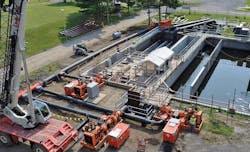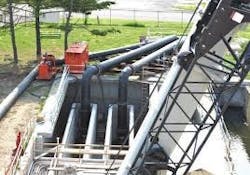Project
New York’s Albany County was in the process of updating its wastewater treatment plants when it turned to BCI Construction for a temporary bypass system to transfer 88 million gallons per day during the project. The county wanted to avoid interruption of sewer service and needed a solution that would allow it to continue replacing its old chlorine bleaching tanks with UV technology.
The upgrades, which took place in the summer 2014, were performed in phases at the county’s North and South Plants. Mark Bacon, project manager for BCI Construction, was responsible for setting up the temporary bypass pumping system and selected Xylem to help design it and provide the optimal equipment. Bacon, who had worked with Xylem before, said the solution they developed minimized the costs of renting for the duration of the project. The team also stepped in with its expertise, offering advice on the supplied pumps. “They helped with a lot of things, from the system setup, design and the maintenance,” he said. “They also knew the equipment well, so they were very helpful and answered all our questions.”
For Xylem’s Seth Morris, P.E., Outside Sales Engineer, and Darrin Ruiz, Regional Applications Engineer, their roles came naturally after learning Xylem was already involved in another aspect of the project. “The municipality chose to install a Wedeco UV system,” said Ruiz. “Wedeco is a Xylem brand of water treatment products and our colleagues in Xylem’s treatment business alerted us to the plants’ need for a bypass pumping system to maintain operations.”
Solution
Renting all of the equipment used in the project, Godwin and BCI outfitted each of its plants’ bypass systems with three CD400M 16-in. Dri-Prime Pumps. At the North Plant, an additional three Godwin Heidra 750AX Axial Flow Dewatering Pumps were added, while the South Plant utilized two.
Level tranducers were used to monitor tank levels and ramp the pumps up and down according to fluctuations in effluent flow. Several heavy rain storms were encountered during the bypass operations and the system did not have any trouble keeping up. Ruiz, who was in charge of the drawings and specifications for the project, described the combination of pumps as “outside the box,” going on to state that, “The axial flow pump isn’t normally used in wastewater treatment plants. It’s usually used for freshwater or flood control in places like Florida. It’s not the norm, but we have used these pumps in similar applications and have had success.”
Originally, BCI requested 12 pumps for each site, but Morris and Ruiz, capitalizing on their familiarity with the equipment, were confident that fewer pumps could handle the job. “We cut the quantity of pumps and the footprint needed by half,” Ruiz said. “This led to a huge reduction in fuel consumption and rental costs.”
The number of pipes used was also much lower than anticipated. According to Morris, who led the design component of the bypass system, only 250 ft of piping was necessary. “And with our equipment actually being able to lie inside the below ground tanks, we also didn’t have to shut down any roads or stop construction from going on,” he said.
Following the bypass system’s installation at the North and South Plants, Xylem’s onsite service team provided routine maintenance for every 250 hours of pump runtime during their operation at the sites. The bypass pumping system was used for three weeks at the North Plant and eight weeks at the South Plant.
Results
The system was in place for approximately three months between the two plants while they were being renovated. There were 2.5 weeks in setup time between the phases, in which Xylem mobilized and installed all the equipment. Zero failures were reported. With the temporary bypass system provided by Xylem, BCI was able to reduce the project footprint and the amount of pumps needed by half. According to Morris, the project saved significant money by specifying a rented system rather than purchasing its own.
It was a decision that made sense. According to BCI’s Bacon, the county government probably wouldn’t have another project like this for years to come. Added Morris: “Renting is the better decision, because the duration of this project did not warrant a purchase of this scale for one time use.” And for this project, the right design was implemented at the time it was needed.
Editor's Note: Scranton Gillette Communications and the SGC Water Group are not liable for the accuracy, efficacy and validity of the claims made in this piece. The views expressed in this content do not reflect the position of the editorial teams of Water & Wastes Digest, Water Quality Products and Storm Water Solutions.

